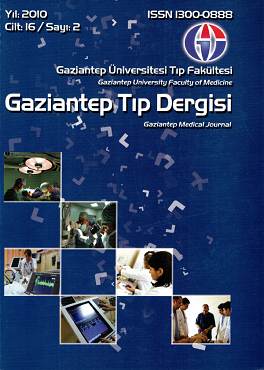Retrospective Evaluation of Pain and Pain Management in Lung Cancer Patients
DOI:
https://doi.org/10.58600/eurjther.2010-16-2-1248-archKeywords:
Lung Cancer, Malign Pain, Pain managementAbstract
We investigated nature of pain and effectiveness of pain management methods applied of the primary lung cancer patients, if their pain's due to primary cancer or metastasis. In this retrospective study, patients with primary lung cancer who treated in our pain clinic were included in this study between January 2004 and January 2009. They were questionared for the pain localisation, onset time and exacerbation period of pain, characteristics of the pain(neuropatic or visserral), VAS, metastasis of cancer, related to cancer treatment. In addition pain affects on sleep, quality of life were questionared. Analgesic therapy and interventional methods applied were examined. One hundered twenty one patients (11 women, 110 men) had applied to pain clinic between the years 2004 -2008. Age range of the patients was 30-80 years. 92 patients defined neuropatic pain, 29 patients defined visseral pain. The localization of pain were mostly at back, shoulder, upper abdomen, lib and legs. In 25 patients pain were primary due to lung cancer, 96 patients' were due to metastasis. Visseral pain had acute onset, within 2 weeks of duration. Onset time of neuropatic pain was 3 months. Exacerbation period of visseral pain was meanly a week, and neuropatic pain was meanly 3 months. We started appropriate treatment from WHO ladder treatments according to their pains. We applicated central or peripheral nevre blockade when medical treatment didn't work in 24 hours. In 95 patients (78.5%) medical treatment worked. But in 26 (21.5 %) patients pain was under-control with central or blockade additional to medical treatment. In 16 of 26 nerve blockade patients, we inserted epidural catheter and in the other 10 patients we applicated intercostal nevre blockade. We applicated suprascapular blockade to 7 patients having shoulder pain. Almost every patients had mood and sleep disorders. We determined that patients with primary lung cancer who admitted to our pain clinic have mostly neuropatic pain usually secondary to metastasis. On the other hand, patients who described visceral pain have shorter duration of pain onset. Pain was controlled with either medical or interventional methods in all patients.
Metrics
References
Montgomery F. Palliative care managing chronic cancer pain. Hospital Pharmacist. 2001;8:215-8.
Rhodes DJ, Koshy RC, Waterfield WC. Feasibility of quantitative pain assessment in outpatient oncology practice. J Clin Oncol. 2001;19:501-8.
Fitzgibbon DR, Chapman CR. Cancer pain: Assessment and diagnosis. In, Loeser JD (Ed.) Bonica's Management of Pain (3th Ed). Philadelphia, Lippincott Williams & Wilkins. 2001;35:623-658.
Yıldırım YK, Uyar M. Etkili kanser ağrı yönetimindeki bariyerler. Ağrı. 2006;18(3):12-19.
Levy MH. Pharmacologic treatment of cancer pain. N Engl J Med. 1996;335:1124-32.
Von Roenn JH, Cleeland CS, Gonin R. Physician attitudes and practice in cancer pain management. A survey from the Eastern Cooperative Oncology Group. Ann Intern Med. 1993;119:121-6.
O'Neill B, Fallon M. ABC of palliative care: Principles of palliative care and pain control. BMJ. 1997;315:801- 4.
Portenoy RK. Adjuvant analgesics in pain management. In: Doyle D, Hanks GWC, MacDonald N, eds. Oxford Textbook of Palliative Medicine. 2nd ed. Oxford: Oxford University Pres, 1998; p:361-90.
Türkiye istatistik Yıllığı 2004 T.C. Başbakanlık Devlet istatistik Enstitüsü ISSN0082-691x; TABLO 4.7, s. 70
Larue F, Colleau SM, Brasseur L. Multicentre study of cancer pain and its treatment in France. BMJ. 1995;310:1034-7.
Jacox A, Carr DB, Payne RB. New clinical-practice guidelines for the management of pain in patients with cancer. N Engl J Med. 1994;330:651-5.
Klave PA, Simoff M, Prakash SB. Palliative care. Chest. 2003;123:284-311.
Em 4. Kannan TR, Saxena A, Bhatnagar S, Barry A. Oral ketamine as an adjuvant to oral morphine for neuropathic pain in cancer patients. J Pain Symptom Manage. 2002;23:60-5.
Mellick GA, Mellicy LB, Mellick LB. Gabapentin in the management of reflex sympathetic dystrophy. J Pain Symptom Manage. 1995;10:265-6.
Lucas LK, Lipman AG. Recent Advances in Pharmacotherapy for cancer pain management. Cancer Pract. 2002;10(1)14-20.
Drourr NR, Bajwa ZH, Warfield CA: Cancer pain. Semin Anesth. 1997;16:105-111.
Starck PL, Sherwood GD,McNeill JA. Pain management outcomes: Issues for advanced practice nurses. Int Adv Nurs Prac. 2000;4:1-9.
Au E, Loprinzi CL, Dhodapkar M. Regular use of a verbal pain scale improves the understading of oncology inpatient pain. J Clin Oncol. 1994;12:2751-5.
Göktalay T, Akın M, Aydemir Ö. Akciğer Kanserli Hastalarda Yaşam Kalitesi Değerlendirilmesi. Solunum Hastalıkları. 2002;13:265-270.
Sevgili S, Karalezli A, Tokgönül AN, Hasanoğlu HC. Akciğer Kanseri Hastalarında Ağrı Değerlendirme Formu Kullanımının Yeri ve Önemi. Solunum Hastalıkları. 2006;17:13-19.
Cleeland CS, Gonin R, Hatfield AK. Pain and its treatment in outpatients with metastatic cancer. N Engl J Med. 1996;335:1124-32.
Aydınlı I. Analjezik kullanım ilkeleri. In, Erdine S. (Ed.) Ağrı (3. Baskı), İstanbul, Nobel Tıp Kitabevleri. 2007;5(68):565-580.
Orhan ME, Bilgin F, Ergin A, Dere K, Güzeldemir ME. Kanser hastalarında WHO analjezik basamak tedavisine göre ağrı tedavisi. Bir merkezin sekiz yıllık deneyimi. Ağrı. 2008;20(4):38-44.
Downloads
Published
How to Cite
Issue
Section
License
Copyright (c) 2023 European Journal of Therapeutics

This work is licensed under a Creative Commons Attribution-NonCommercial 4.0 International License.
The content of this journal is licensed under a Creative Commons Attribution-NonCommercial 4.0 International License.


















